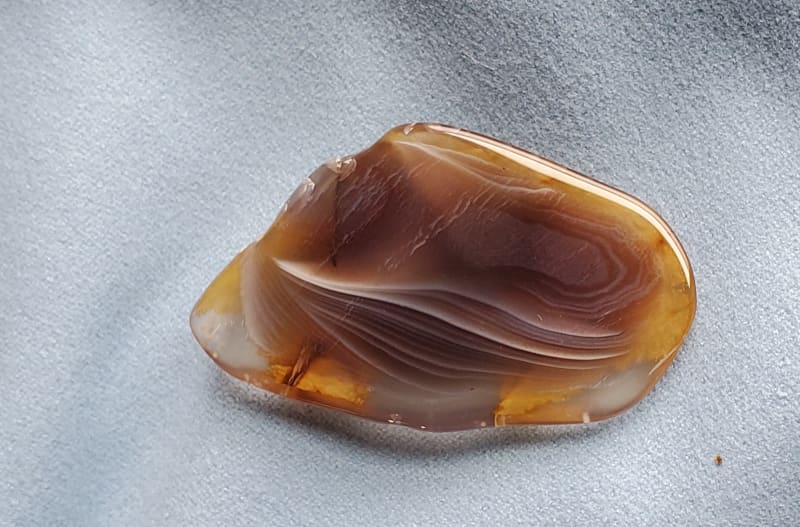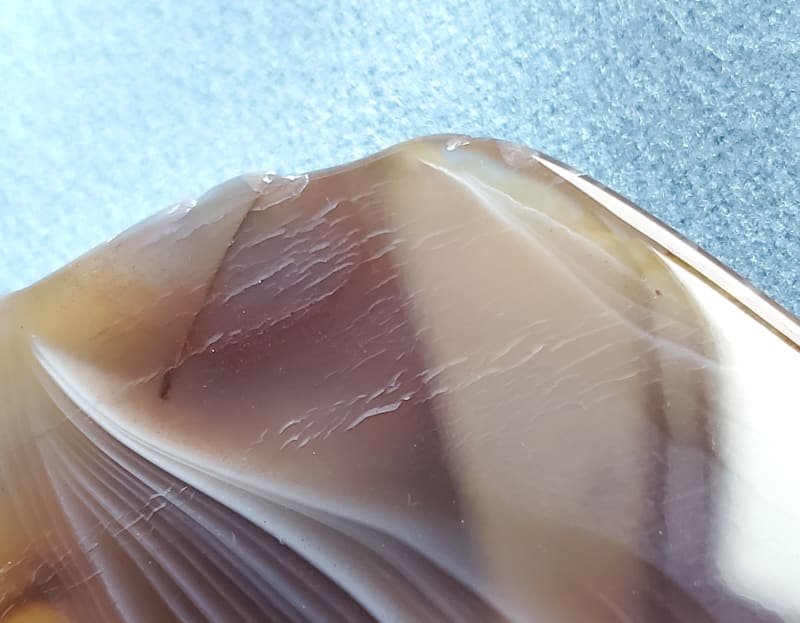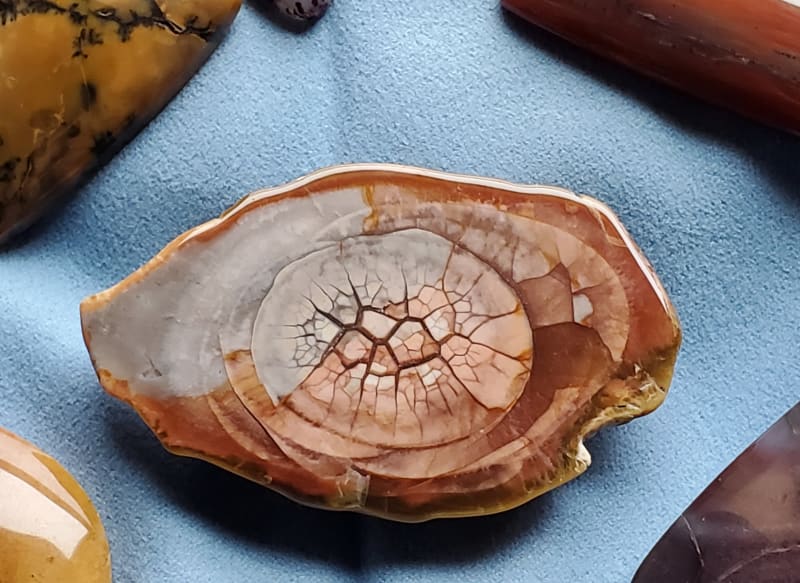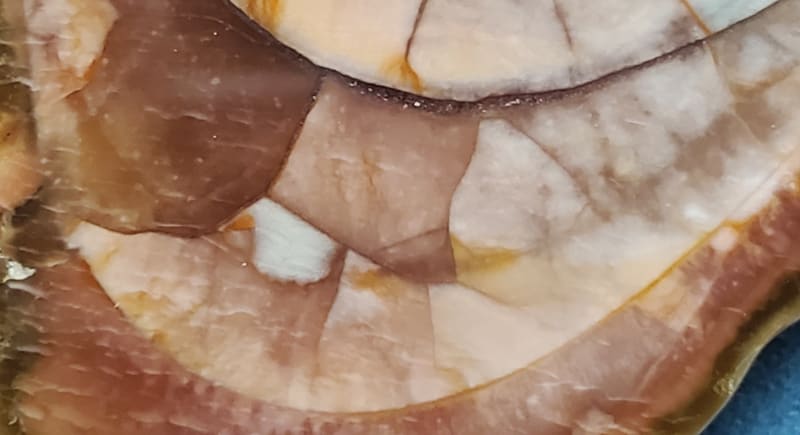Micro fractures from hand slabbing with a trim saw
Oct 15, 2021 15:17:47 GMT -5
hummingbirdstones, jasoninsd, and 1 more like this
Post by holajonathan on Oct 15, 2021 15:17:47 GMT -5
I have a high speed (5000 rpm) 10" trim saw with a 1 hp motor. I have enjoyed ramming rocks through it as if it were a table saw cutting wood. I am exaggerating a little, but I do use some pressure when cutting because the motor does not bog down, and if I want to spend all day slabbing a few small rocks, I've got slab saws.
With most rocks, my hand-fed small slabs are fine. Really hard fracture-prone agates and jaspers, however, often end up with micro fractures. I have only had this problem with rocks like Botswana agates, Montana agates, and Royal Imperial Jasper -- all very hard and fracture prone. Although feeding the rocks with too much force makes more of these micro fractures, they sometimes occur even when I feed very. I think the rip fence is part of the problem, especially if I do not have it set perfectly parallel to the blade.
What is maddening about these tiny fractures is that they are usually not visible until the rock is polished, and even then, are sometimes visible only from a certain angle. Other times, the fractures are so small, they are hardly visible even when polished, but the polish simply doesn't look very good. If I tumble away the cut surface, however, the same rocks take a great polish. (An internal fracture cannot expand or open up, so many of these tiny fractures cannot be felt with a fingernail. Nevertheless they distort the way lights reflects off the rock, or in the case of translucent rocks, distorts the passage of light through the rock).
The problem is especially troublesome when cabbing. In my case at least, it explains the common problem of "scratches" on the top of the dome that won't seem to go away. The edges and sides of the dome are ground low enough that the tiny fractures are removed. But little material is removed from the center of the dome, so the fractures usually show up only in that part of the cab. On a cab, these micro fractures look like scratches, and I usually don't see them not see them until the 1200 or 3000 grit wheel. If I jump back to one of the hard wheels to removed the "scratches," they usually reappear again when I return to the fine grit wheels -- because they are not scratches at all, but fractures. They are so hard to get rid of because they may be 1mm or more deep, and removing that much material from the top of the dome requires reworking the whole cab.
I am sharing this insight after much frustration trying to remove "scratches" from the high point on cab domes. I realized that I was having this problem only when cabbing rocks hand slabbed on my trim saw. Slabs from my slab saws don't have this problem, probably due to the slow feed rate and very straight path of the blade.
Here are two rocks that I cut on my trim saw and threw into the Lot-O tumbler. Both have a very high polish, but both also have bands of micro fractures that show up in curved, parallel lines -- precisely the shape of the saw blade. These are especially obvious examples, and I took the photographs to make the fractures as visible as possible. The problem is usually more subtle. But even with these rocks, the micro fractures were not visible until the rocks were polished.




I just wanted to point this issue out so that others who slab rocks by hand are aware of the potential issue. I don't know if the problem is unique to my high speed trim saw + rip fence setup, but I suspect that many others deal with the same issue. I have taken cuts from the rock with both my trim saw and one of my slab saws, and I confirmed that the trim saw slab had these fractures, and the slab saw slab did not. The were even both running the identical 10" blade, so the blade does not seem to be the issue.
To remove these fractures, I can either tumble them a week or two in a rotary tumbler, of if I want them to stay flat, I can patiently grind away about 1mm from the surface with a flat lap, using a 150 or 220 grit disc.
With most rocks, my hand-fed small slabs are fine. Really hard fracture-prone agates and jaspers, however, often end up with micro fractures. I have only had this problem with rocks like Botswana agates, Montana agates, and Royal Imperial Jasper -- all very hard and fracture prone. Although feeding the rocks with too much force makes more of these micro fractures, they sometimes occur even when I feed very. I think the rip fence is part of the problem, especially if I do not have it set perfectly parallel to the blade.
What is maddening about these tiny fractures is that they are usually not visible until the rock is polished, and even then, are sometimes visible only from a certain angle. Other times, the fractures are so small, they are hardly visible even when polished, but the polish simply doesn't look very good. If I tumble away the cut surface, however, the same rocks take a great polish. (An internal fracture cannot expand or open up, so many of these tiny fractures cannot be felt with a fingernail. Nevertheless they distort the way lights reflects off the rock, or in the case of translucent rocks, distorts the passage of light through the rock).
The problem is especially troublesome when cabbing. In my case at least, it explains the common problem of "scratches" on the top of the dome that won't seem to go away. The edges and sides of the dome are ground low enough that the tiny fractures are removed. But little material is removed from the center of the dome, so the fractures usually show up only in that part of the cab. On a cab, these micro fractures look like scratches, and I usually don't see them not see them until the 1200 or 3000 grit wheel. If I jump back to one of the hard wheels to removed the "scratches," they usually reappear again when I return to the fine grit wheels -- because they are not scratches at all, but fractures. They are so hard to get rid of because they may be 1mm or more deep, and removing that much material from the top of the dome requires reworking the whole cab.
I am sharing this insight after much frustration trying to remove "scratches" from the high point on cab domes. I realized that I was having this problem only when cabbing rocks hand slabbed on my trim saw. Slabs from my slab saws don't have this problem, probably due to the slow feed rate and very straight path of the blade.
Here are two rocks that I cut on my trim saw and threw into the Lot-O tumbler. Both have a very high polish, but both also have bands of micro fractures that show up in curved, parallel lines -- precisely the shape of the saw blade. These are especially obvious examples, and I took the photographs to make the fractures as visible as possible. The problem is usually more subtle. But even with these rocks, the micro fractures were not visible until the rocks were polished.




I just wanted to point this issue out so that others who slab rocks by hand are aware of the potential issue. I don't know if the problem is unique to my high speed trim saw + rip fence setup, but I suspect that many others deal with the same issue. I have taken cuts from the rock with both my trim saw and one of my slab saws, and I confirmed that the trim saw slab had these fractures, and the slab saw slab did not. The were even both running the identical 10" blade, so the blade does not seem to be the issue.
To remove these fractures, I can either tumble them a week or two in a rotary tumbler, of if I want them to stay flat, I can patiently grind away about 1mm from the surface with a flat lap, using a 150 or 220 grit disc.













